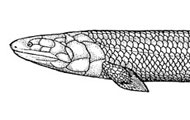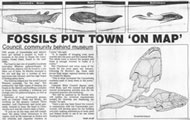- Mt. Canobolas & Lake Canobolas
- Rain & Floods
- Object :: Pluviometer
- Object :: Tipping Bucket
- Object :: Rainfall Records
- Introducing Water in Orange
- Object :: Douglas Pump
- Spiritual Dimensions
- Interview :: Ian Marr
- Object :: Ian Marr Bench
- Interview :: Carl MacKander
- Object :: Baptismal Font
- Object :: Chalices
- Interview :: Mandy Martin
- Wiradjuri People
- Interview :: Joyce Williams
- Object :: Painting by Joanne Reid
- Canowindra Fish Fossils
- Object :: Fossils
- Swamps & Wetlands
- Interview :: Rodney Tonkin
- Interview :: Jill Campbell
- Object :: Willow
Canowindra Fish Fossils
A chance discovery by a country road-worker in 1956 led to one of the world’s great fossil discoveries at Canowindra in NSW. The road-worker turned over a rock slab, saw strange markings on the rock under-surface, pushed it aside and saved it.

The original slab was sent to Australian Museum where it has been on display since 1966. This 1956 slab bears detailed impressions or natural moulds of more than 100 Late Devonian fish, most of them complete. Four different types of fish are present on the original slab.
Between 1976 and 1990 numerous attempts were made to relocate the site. With the assistance of Cabonne Council and the Canowindra community the site was re-discovered in 1993. A major excavation took place in July 1993 resulting in the excavation of 70 tonnes of fossil slabs. The new slabs contain more than 3100 fossil fish specimens. Most of the specimens are complete and they represent at least 8 species, all new to science.
The discovery of the Canowindra fishes has had and continues to have a huge impact on science. Some of the more important discoveries are outlined below:
- The largest fish in the collection, the Mandageria fairfaxi is the only fish ever found to have had a neck. The recent discovery of this is having an impact on the study of evolution worldwide.
- The Canowindra fauna is the only known mass kill population study for the Devonian period in the world. In layman’s terms, its kind of like finding Pompeii, only the community is 360 million years old.
- In total eight species of fishes have been found; all of them are new to science.

Canowindra - fossil
The Age of Fishes Museum is one of only two fish fossil museums in the world. This alone attests to the significance of the collection and the importance of the work the community is doing to ensure the collection is accessible to all people. The Museum displays many of these beautiful fossils together with live aquarium displays and wonderful recreations of life in the Devonian period.